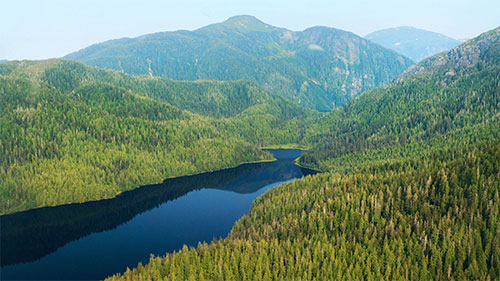
Amended Tongass Forest Plan Focuses on Transition to Young Growth Harvest and Renewable Energy Development
December 11, 2016
The Tongass Forest Plan Amendment focuses on accelerating the transition from old-growth timber harvest to young-growth while maintaining opportunities for a viable timber industry in Southeast Alaska. The amended plan will support more sustainable and diverse local economies by stabilizing timber supply, minimizing social conflict about the harvest of old growth trees, and maintaining wildlife habitat. The amended plan also contributes to sustainable and diverse local economies by promoting renewable energy development.
A summer-time glimpse of a very small part of the Tongass National Forest “Through years of community collaboration efforts, the Tongass has sought a resolution to long-standing conflicts regarding timber management,” said Earl Stewart, Tongass Forest Supervisor. “This amendment is the culmination of those collaborative efforts, and it is aligned with the unanimous recommendations of the Tongass Advisory Committee (TAC).” The amended plan reflects the unanimous recommendations of the Tongass Advisory Committee to the Forest Service. The TAC included 15 members who represented a broad and diverse range of viewpoints and expertise. They were from geographically diverse communities in Alaska and the western U.S. and included representatives of state and local government, Alaska Native Corporations, the timber industry, the environmental community and the general public. Consistent with one of the TAC’s recommendations, the plan amendment embraces an adaptive management strategy, and includes commitments to complete an ongoing young growth inventory with the State of Alaska, monitor actual timber harvest levels compared to projected levels, review the effects of harvesting young growth in priority areas, review the effectiveness of the plan at five and ten years, and adjust management as needed. The plan amendment has a narrow focus and maintains the Tongass Conservation Strategy. Wilderness or Wild and Scenic River Designations from the 2008 Forest Plan did not change. The final ROD does not propose rulemaking to modify the 2001 Roadless Rule application to the Tongass National Forest. The amended plan and ROD are the culmination of a comprehensive public involvement process that sought, and carefully considered, input from the public, youth, local, state and federal agencies, federally recognized tribes, as well as previous decades of collaborative efforts. They are also consistent with a 2013 Memorandum from Agriculture Secretary Tom Vilsack, who directed consideration of an amendment to the Tongass Forest Plan to promote a transition to young-growth management. “We remain concerned with the Amended Plan’s allowance of 10-acre clearcuts inside the previous Plan’s conservation areas,” said Melanie Smith, Audubon Alaska’s Director of Conservation Science. “However, the agency has indicated that such cuts will only occur insofar as they emulate natural disturbance regimes. Given that 10-acre gaps are vanishingly rare in nature, the agency should seldom implement cuts larger than a couple acres.” “This Amended Plan keeps momentum moving toward ending the long-outdated practice of old-growth clearcut logging on the Tongass,” said Susan Culliney, Audubon Alaska’s Policy Associate. “Cutting giant old trees in the remote and wild Tongass racks up economic, social, and environmental deficits. Instead, the government should invest in the Tongass’ sustainable forest resources, such as its unparalleled wild places, which support world-class economies in recreation, salmon, and tourism.” Audubon Alaska stated they will continue to advocate for a rapid phase-out of clearcut logging of old-growth forests and draw on the best available science to inform Tongass land management decisions, including implementation of the Amended Plan announced Friday. Fishing and tourism are local industries that offer a brighter and more balanced future for the Southeast region according to these two conservation groups. Tongass wildlife - from bears to bald eagles - draws tourists from around the globe. According to an Alaska’s Southeast Conference Report, tourism in Southeast Alaska “is growing at 4% per year for the foreseeable future.” A science-based Wildlife Conservation Strategy, embodied in the 2008 TLMP, imposes logging prohibitions and maintains connectivity in important salmon and wildlife habitat such as beach fringe buffers, riparian management areas, and old-growth reserves. The Amended Plan opens these same areas to limited timber harvest of second-growth forests. After publication of the draft amendment, public meetings and federal subsistence hearings that were held in nine communities across Southeast Alaska, approximately 165,000 public comments were received on the proposed amended plan and DEIS. Tribal organizations and corporations were engaged and consulted in the planning process, as were local youth from Ketchikan High School. Following review and written response to issues raised in eligible objections, the final ROD is now published. The amended Forest Plan will become effective 30 days from publication. The Tongass National Forest, the nation's largest national forest at 17 million acres covers most of Southeast Alaska.
Reporting & Editing by Mary Kauffman, SitNews
Source of News:
Representations of fact and opinions in comments posted are solely those of the individual posters and do not represent the opinions of Sitnews.
|
||
